
19
GB/IE
• Check for potential causes of accidents in
the fl ying area, e.g. candles or glasses, and
ensure that there are no children, pets or
other animals in the vicinity of the quadcopter.
Maintain a distance of at least 5m.
• Only use outdoors – not indoors. Risk of eye
injuries.
• Outdoors, the quadcopter must not be fl own
beyond your line of sight, and may not fl y
higher than a maximum altitude of 100m.
• Always maintain a minimum distance of 5m.
• Do not fl y the quadcopter in areas where
temperatures can change rapidly, e.g. over a
fi re or over water surfaces.
• Select a suitable location (open space) to
operate the quadcopter. Flying over the fol-
lowing areas is prohibited, and a distance of
100m from these areas must be maintained:
crowded areas, accident sites, disaster areas
and other areas where public authorities and
organisations are engaged in security/safety
activities; over mobile federal army instal-
lations and troops conducting announced
manoeuvres and military exercises; traffi c
routes; nature conservation areas; residential
areas; industrial plants; penal institutions;
involuntary treatment facilities; military instal-
lations and organisations; power generation
and distribution infrastructure; facilities in
which Protection Level 4 work requiring prior
authorisation under the Ordinance on Bio-
logical Substances is carried out, unless the
facility operator has given express permission;
hospitals; public highways; public waterways;
railway infrastructure; state and county consti-
tutional bodies or supreme or higher state or
county authorities; embassies and consulates;
international organisations that are located
in an area based on international law; and
police property and property of other security
agencies.
Flight over the following areas is prohibited,
and a distance of 1.5km from these areas
must be maintained: airports, airfi eld control
zones, state and military buildings. Local fl ight
exclusion zones must be checked before each
fl ight.
• The quadcopter has been designed for use
by laypeople as well as experienced/trained
users. Users with vision or hearing impair-
ments must only use the quadcopter under the
supervision of those without impairments.
• The user’s reactive capacity must not be
compromised: tiredness, and the infl uence of
alcohol or medication can lead to incorrect
responses.
• Additional skills are not required (e.g. training,
etc.). There are no operating restrictions
based on gender or left/right-handedness.
• Never fl y the quadcopter directly at other
people, animals or yourself.
• The motor, electronics and rechargeable
battery can heat up while the quadcopter is
in operation. For this reason, take a break of
5–10 minutes before recharging the battery
or installing another previously charged
battery.
• Improper operation can cause serious person-
al injury and damage to property!
• For this reason, make sure that you maintain a
safe distance from other people, animals and
objects when fl ying.
• Always leave the remote control switched on
while the quadcopter is in operation.
Switch the quadcopter off after landing it. The
remote control can then be switched off .
• In the event of a defect or a malfunction, the
cause of the defect must fi rst be resolved
before you restart the quadcopter.
• Do not expose the quadcopter or the remote
control to direct sunlight or high temperatures
for extended periods of time.
• In the event of a serious crash (for example,
from a signifi cant height), the calibration may
be damaged or detuned. It is therefore imper-
ative that complete functionality is checked
before a new fl ight!
• In the event of a crash, the throttle must be
brought down to zero immediately. Rotating
rotors can be damaged during contact with
obstacles or on impact. Before a new fl ight,
always check them for possible cracks or
breakages!
• In order to prevent damage to the quadcopter
from crashing due to under-voltage, or to the
rechargeable battery due to deep discharge,
always keep a close eye on the under-voltage
indicator lights (see section on ‘Under-voltage
warning’).
• In some countries, insurance is mandatory
for model aircraft and model helicopters
which are fl own outdoors. Please consult your
personal liability insurer and ensure that your
quadcopter is included in this insurance.
• In the event of loss of data or a connection
failure between the remote control and quad-
copter, the quadcopter commences landing.
Battery warning notices!
GENERAL WARNING NOTICES
• Always keep batteries out of reach of children.
• Cleaning and maintenance must not be car-
ried out by children without supervision.
• When necessary, clean the battery and de-
vice contacts with a clean, dry cloth.
• Do not expose the batteries to extreme condi-
tions (e.g. radiators or direct sunlight).
• Handle damaged or leaking batteries with
extreme caution and dispose of them properly
as soon as possible. Wear gloves when doing
so.
• If you come into contact with battery acid,
wash the affected area with soap and water.
If battery acid gets in your eye, rinse it with
water and seek medical attention immediate-
ly!
• Batteries must not be swallowed! If this does
happen, you must see a doctor immediately!
• Never throw batteries or the rechargeable
battery into fire or put them on hot surfaces
(e.g. a radiator or a stove). Never open the
battery casing or the foil or short-circuit the
contacts. There is a risk of fire or explosion!
• Avoid external mechanical influences (e.g.
blows, sharp objects or crushing). There is a
risk of fire or explosion!
• Do not expose the batteries or the recharge-
able battery to temperatures below 10°C or
over 45°C.
ADDITIONAL BATTERY WARNING
NOTICES (REMOTE CONTROL)
• Only use batteries from the same manufactur-
er and of the same type.
• Remove the batteries when they are flat, or
if the product is not in use for an extended
period.
• New and used batteries must not be used
together.
• Replace all batteries at the same time.
• Non-rechargeable batteries must not be
charged.
• Warning:
batteries must not be charged or
reactivated by other means, must not be taken
apart, thrown into fire or short-circuited. There
is a risk of fire or explosion!
• Pay attention to the correct polarity (+/-) when
inserting the batteries.
• Dispose of used batteries properly at local
collection points or retailers.
ADDITIONAL WARNINGS FOR
RECHARGEABLE BATTERY (QUAD-
COPTER)
• Never leave batteries charging unattended.
• Never charge the rechargeable battery
immediately after use. Always allow the re-
chargeable battery to cool down first (at least
5–10 minutes).
• Only use the USB cable provided to charge
the rechargeable battery.
• Only charge intact and undamaged recharge-
able batteries. If the outer insulation of the bat-
tery is damaged or if the battery is deformed
or bloated, it must not be charged under any
circumstances. In this case, there is an acute
risk of fire and explosion!
• Since both the USB cable and the recharge-
able battery heat up during the charging
process, it is vital to ensure there is adequate
ventilation. Never cover the USB cable or the
battery!
• Disconnect the battery from the USB cable
when it is fully charged.
• Never charge or store the rechargeable bat-
tery near large heat sources or open fires, as
this could result in a fire or an explosion.
• Do not leave the rechargeable battery
unattended while charging, and watch out
for possible overheating of the rechargeable
battery.
• Never charge a rechargeable battery that
has expanded as a result of overheating,
dropping or overcharging.
• Never charge a rechargeable battery that
is punctured or damaged. Examine the
rechargeable battery very closely for such
damage if it has been dropped. If the re-
chargeable battery is damaged, dispose of it
according to the regulations in your country.
• If the rechargeable battery catches fire during
the charging process, extinguish this type of
battery with plenty of water.
• The USB cable must only be used in dry,
enclosed indoor areas. The USB cable and
rechargeable battery must not get damp or
wet.
• Never short-circuit the rechargeable battery.
There is a risk of fire or explosion.
Содержание 345898 2004
Страница 2: ...B G F H I J K E A C D ...
Страница 3: ...5 L N M P O R Q ...
Страница 53: ...55 ...
Страница 54: ...56 03 09 2021 AM 11 32 ...


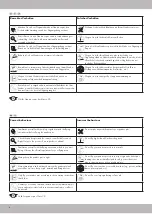


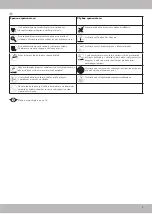
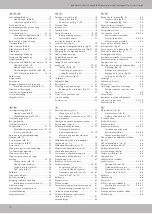
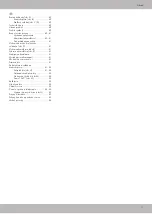
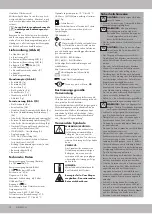

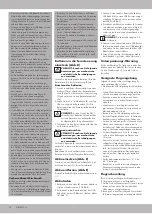
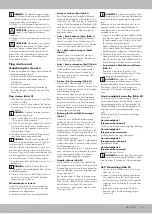
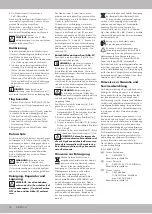
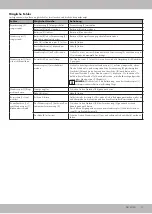
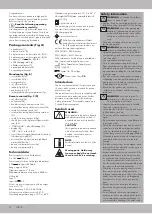
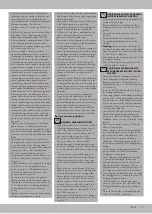
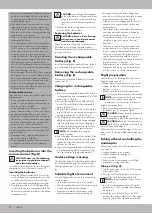
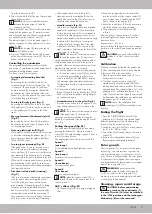

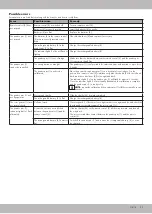
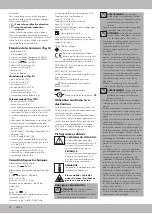
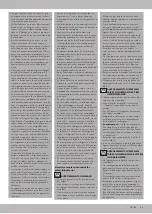
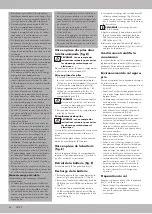
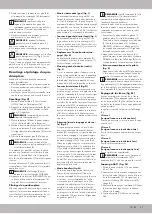
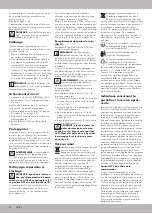
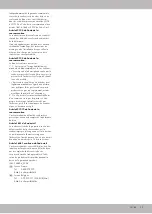
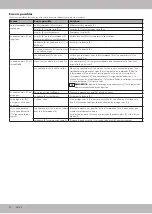

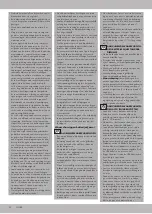
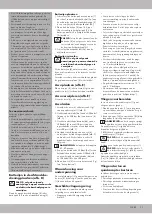








![Navig[8]r NAV-RCDRONE15 User Manual preview](http://thumbs.mh-extra.com/thumbs/navig-8-r/nav-rcdrone15/nav-rcdrone15_user-manual_3573005-01.webp)




